On the Rarefied Thermally-Driven Flows in Cavities and Bends
Abstract
1. Introduction
2. Techniques
2.1. DSMC, or Direct Simulation Monte Carlo Method
2.2. DUGKS, or Discrete Unified Gas Kinetic Scheme
2.3. SNIT (Slow Non-Isothermal Thermal)
3. Geometry and Verification
3.1. The Geometry
3.2. Grid and Particle Independence Test of DSMC Solver for Cases 1 and 2
3.3. Verification of the DUGKS Solver for Cases 1 and 2
3.4. Verification of the SNIT Solver for Cases 1 and 2
4. Results and Discussion
4.1. Streamlines and Temperature Contours in the Square Cavity in Case 1
4.2. Velocity Distribution and Force in Case 1 with the DSMC Solver
4.3. Comparison of the DUGKS and DSMC Solvers for Case 1
4.4. SNIT Solver for Case 1
4.5. Streamlines and Temperature Contours in the Rectangular Bend in Case 2
4.6. Velocity Distribution and Force in Case 2 with the DSMC Solver
4.7. Comparison of the DUGKS and DSMC Solvers in Case 2
4.8. Verification of the SNIT Solver for Case 2
4.9. Average velocity in Cases 1 and 2
5. Conclusions
Author Contributions
Funding
Institutional Review Board Statement
Informed Consent Statement
Data Availability Statement
Conflicts of Interest
Nomenclature
| c | Peculiar velocity | R | Gas Constant |
| D | Operator describing particle convection | SOF | Separation of free path |
| d | Mean molecular diameter | Streaming operator | |
| EV | Inaccuracy in velocity | Collision operator | |
| f | Velocity distribution function | T | Temperature |
| Velocity distribution function | TH | Hot temperature | |
| Fluid-dynamic part of the velocity distribution function | TC | Cold temperature | |
| Knudsen-layer adjustment | Temperature | ||
| Maxwell distribution function | Characteristic time | ||
| Shakhov equilibrium distribution function | U,V | Velocity components | |
| Force in direction y | uiH | Velocity | |
| γ | Ratio of specific heat capacity | ||
| g | Relative velocity of molecules | Time step | |
| hH | Arbitrary variable | Kronecker delta function | |
| Kn | Knudsen number | θ | Unit vector |
| L | Length | λ | Mean free path |
| Mach | Mach number | non-dimensional coefficients | |
| m | Molecular Mass | Viscosity coefficient | |
| P | Pressure | π | Pi |
| PPC | Particle per cell | ρ | Density |
| Pr | Prandtl number | τ | Relaxation time |
| Function of pressure | Ω | Solid angle element | |
| Q | Operator describing binary interactions | Viscosity-Temperature index | |
| q | Heat flux |
References
- Karniadakis, G.; Beskok, A.; Aluru, N. Microflows and Nanoflows: Fundamentals and Simulation; Springer Science & Business Media: Berlin/Heidelberg, Germany, 2006; Volume 29. [Google Scholar]
- Mohammadzadeh, A.; Roohi, E.; Niazmand, H.; Stefanov, S.; Myong, R.S. Thermal and second-law analysis of a micro- or nano-cavity using direct-simulation Monte Carlo. Phys. Rev. E 2012, 85, 056305. [Google Scholar] [CrossRef] [PubMed]
- Bird, G.A. Molecular Gas Dynamics and the Direct Simulation of Gas Flows; Oxford University Press: Oxford, UK, 1994. [Google Scholar]
- Rader, D.J.; Gallis, M.A.; Torczynski, J.R.; Wagner, W. Direct simulation Monte Carlo convergence behavior of the hard-sphere-gas thermal conductivity for Fourier heat flow. Phys. Fluids 2006, 18, 077102. [Google Scholar] [CrossRef]
- Bird, G.A. Sophisticated Versus Simple DSMC. In Rarefied Gas Dyn. 25th Int. Symp.; Ivanov, M.S., Rebrov, A.K., Eds.; House of the Siberian Branch of the Russian Academy of Sciences: Novosibirsk, Russia, 2007; pp. 349–357. [Google Scholar]
- Bird, G.A.; Gallis, M.A.; Torczynski, J.R.; Rader, D.J. Accuracy and efficiency of the sophisticated direct simulation Monte Carlo algorithm for simulating noncontinuum gas flows. Phys. Fluids 2009, 21, 017103. [Google Scholar] [CrossRef]
- Bird, G.A. The DSMC Method; CreateSpace Independent Publishing Platform: Scotts Valley, CA, USA, 2013. [Google Scholar]
- Boyd, I.D.; Schwartzentruber, T.E. Nonequilibrium Gas Dynamics and Molecular Simulation; Cambridge University Press: Cambridge, MA, USA, 2017; Volume 42. [Google Scholar]
- Sone, Y. Molecular Gas Dynamics: Theory, Techniques, and Applications; Springer Science & Business Media: Berlin/Heidelberg, Germany, 2007. [Google Scholar]
- Aoki, K.; Sone, Y.; Masukawa, N. A Rarefied Gas Flow Induced by a Temperature Field. In Rarefied Gas Dynamics; Harvey, J., Lord, G., Eds.; Oxford University Press: Oxford, UK, 1995; pp. 35–41. [Google Scholar]
- Aoki, K.; Takata, S.; Aikawa, H.; Golse, F. A rarefied gas flow caused by a discontinuous wall temperature. Phys. Fluids 2001, 13, 2645–2661. [Google Scholar] [CrossRef]
- Han, Y.L.; Muntz, E.P.; Alexeenko, A.; Young, M. Experimental and Computational Studies of Temperature Gradient–Driven Molecular Transport in Gas Flows through Nano/Microscale Channels. Nanoscale Microscale Thermophys. Eng. 2007, 11, 151–175. [Google Scholar] [CrossRef]
- Taguchi, S.; Aoki, K. Rarefied gas flow around a sharp edge induced by a temperature field. J. Fluid Mech. 2012, 694, 191–224. [Google Scholar] [CrossRef]
- Taguchi, S.; Aoki, K. Motion of an array of plates in a rarefied gas caused by radiometric force. Phys. Rev. E 2015, 91, 063007. [Google Scholar] [CrossRef]
- Taguchi, S.; Tsuji, T. On the motion of slightly rarefied gas induced by a discontinuous surface temperature. J. Fluid Mech. 2020, 897, A16. [Google Scholar] [CrossRef]
- Wang, X.; Zhang, W.; Su, T.; Zhang, Z.; Zhang, S. Gas-surface interaction effects on rarefied gas flows around microbeams induced by temperature fields. Int. J. Heat Mass Transf. 2021, 172, 121186. [Google Scholar] [CrossRef]
- Zeng, D.; Cai, R.; Yang, Y. Rarefied gas flow around a double-plate induced by temperature difference. Adv. Space Res. 2022, 69, 737–750. [Google Scholar] [CrossRef]
- Yazdanpanah, E.; Roohi, E.; Abolfazli, J. Flow field and heat transfer characteristics of thermal cavities. Vacuum 2014, 109, 333–340. [Google Scholar]
- Shahabi, V.; Baier, T.; Roohi, E.; Hardt, S. Thermally-induced gas flow in ratchet channels with diffuse and specular walls. Sci. Rep. 2017, 7, 41412. [Google Scholar] [CrossRef] [PubMed]
- Baier, T.; Hardt, S.; Shahabi, V.; Roohi, E. Knudsen pump inspired by Crookes radiometer with a specular wall. Phys. Rev. Fluids 2017, 2, 033401. [Google Scholar] [CrossRef]
- Lotfian, A.; Roohi, E. Radiometric Flow in Periodically Patterned Channels: Fluid Physics and Improved Configurations. J. Fluid Mech. 2019, 860, 544–576. [Google Scholar] [CrossRef]
- Lotfian, A.; Roohi, E. Binary gas mixtures separation using micro-scale radiometric pumps. Int. Commun. Heat Mass Transf. 2021, 121, 105061. [Google Scholar] [CrossRef]
- RafieeNasab, S.; Roohi, E.; Teymourtash, A. Numerical analysis of nonlinear thermal stress flow between concentric elliptical cylinders. Phys. Fluids 2020, 32, 102007. [Google Scholar] [CrossRef]
- John, B.; Gu, X.J.; Emerson, D.R. Investigation of heat and mass transfer in a lid driven cavity under non-equilibrium flow conditions. Numer. Heat Transf. Part B Fundam 2010, 58, 287–303. [Google Scholar] [CrossRef]
- John, B.; Gu, X.-J.; Emerson, D.R. Effects of incomplete surface accommodation on non-equilibrium heat transfer in cavity flow: A parallel DSMC study. Comput. Fluids 2011, 45, 197–201. [Google Scholar] [CrossRef]
- Mohammadzadeh, A.; Roohi, E.; Niazmand, H. A Parallel DSMC Investigation of Monatomic/Diatomic Gas Flows in a Micro/Nano Cavity. Numer. Heat Transf. Part A Appl. 2013, 63, 305–325. [Google Scholar] [CrossRef]
- Vargas, M.; Tatsios, G.; Valougeorgis, D.; Stefanov, S. Rarefied gas flow in a rectangular enclosure induced by non-isothermal walls. Phys. Fluids 2014, 26, 057101. [Google Scholar] [CrossRef]
- Akhlaghi, H.; Roohi, E.; Stefanov, S. Ballistic and Collisional Flow Contributions to Anti-Fourier Heat Transfer in Rarefied Cavity Flow. Sci. Rep. 2018, 8, 13533. [Google Scholar] [CrossRef] [PubMed]
- Roohi, E.; Shahabi, V.; Bagherzadeh, A. On the vortical characteristics and cold-to-hot transfer of rarefied flow in a lid-driven isosceles orthogonal triangular cavity with isothermal walls. Int. J. Therm. Sci. 2018, 125, 381–394. [Google Scholar] [CrossRef]
- Venugopal, V.; Praturi, D.S.; Girimaji, S.S. Non-equilibrium thermal transport and entropy analyses in rarefied cavity flows. J. Fluid Mech. 2019, 864, 995–1025. [Google Scholar] [CrossRef]
- Zhang, J.; Yao, S.; Fei, F.; Ghalambaz, M.; Wen, D. Competition of natural convection and thermal creep in a square enclosure. Phys. Fluids 2020, 32, 102001. [Google Scholar] [CrossRef]
- Zakeri, M.; Roohi, E. Flow and thermal field investigation of rarefied gas in a trapezoidal micro/nano-cavity using DSMC. Int. J. Mod. Phys. C 2021, 32, 17. [Google Scholar] [CrossRef]
- Garg, R.; Agrawal, A. Influence of three-dimensional transverse micro-ridges on the Poiseuille number in a gaseous slip flow. SN Appl. Sci. 2019, 1, 1–18. [Google Scholar]
- Garg, R.; Mujumdar, S.; Agrawal, A. Pumping Power Performance and Frictional Resistance of Textured Microchannels in Gaseous Slip Flows. Ind. Eng. Chem. Res. 2021, 60, 2290–2299. [Google Scholar] [CrossRef]
- Liu, C.; Xu, K.; Sun, Q.; Cai, Q. A unified gas-kinetic scheme for continuum and rarefied flows IV: Full Boltzmann and model equations. J. Comput. Phys. 2016, 314, 305–340. [Google Scholar] [CrossRef][Green Version]
- Ghia, U.; Ghia, K.N.; Shin, C.T. High-Re Solutions for Incompressible Flow Using the Navier-Stokes Equations and a Multigrid Method. J. Comput. Phys. 1982, 48, 387–411. [Google Scholar] [CrossRef]
- Stefanov, S.K. On the basic concepts of the direct simulation Monte Carlo method. Phys. Fluids 2019, 31, 067104. [Google Scholar] [CrossRef]
- Goshayeshi, B.; Roohi, E.; Stefanov, S. DSMC simulation of hypersonic flows using an improved SBT-TAS technique. J. Comput. Phys. 2015, 303, 28–44. [Google Scholar] [CrossRef]
- Akhlaghi, H.; Roohi, E.; Daliri, A.; Soltani, M.R. Shock Polar Investigation in Supersonic Rarefied Gas Flows over a Circular Cylinder. Phys. Fluids 2021, 33, 052006. [Google Scholar] [CrossRef]
- Akhlaghi, H.; Roohi, E. Generalized description of the Knudsen layer thickness in rarefied gas flows. Phys. Fluids 2021, 33, 061701. [Google Scholar] [CrossRef]
- Liu, W.; Zhang, J.; Jiang, Y.; Chen, L.; Lee, C.-H. DSMC study of hypersonic rarefied flow using the Cercignani–Lampis–Lord model and a molecular-dynamics-based scattering database. Phys. Fluids 2021, 33, 072003. [Google Scholar] [CrossRef]
- Taheri, E.; Roohi, E.; Stefanov, S. A symmetrized and simplified Bernoulli trial collision scheme in direct simulation Monte Carlo. Phys. Fluids 2022, 34, 012010. [Google Scholar] [CrossRef]
- Lu, X.; Ye, Z. A universal method of redistributing relaxation energies in inelastic molecular collisions. Phys. Fluids 2022, 34, 036106. [Google Scholar] [CrossRef]
- White, C.; Borg, M.; Scanlon, T.; Longshaw, S.; John, B.; Emerson, D.; Reese, J. dsmcFoam+: An OpenFOAM based direct simulation Monte Carlo solver. Comput. Phys. Commun. 2018, 224, 22–43. [Google Scholar] [CrossRef]
- Zhu, L.; Guo, Z. Application of discrete unified gas kinetic scheme to thermally induced non-equilibrium flows. Comput. Fluids 2017, 193, 103613. [Google Scholar] [CrossRef]
- Guo, Z.; Wang, R.; Xu, K. Discrete unified gas kinetic scheme for all Knudsen number flows: II. Compressible case, Physical review. E Stat. Nonlinear Soft Matter Phys. 2014, 91, 033313. [Google Scholar] [CrossRef]
- Galkin, V.S.; Kogan, M.N.; Fridlender, O.G. Some kinetic effects in continuum flows. Fluid Dyn. 1973, 5, 364–371. [Google Scholar] [CrossRef]
- Sone, Y.; Aoki, K.; Takata, S.; Sugimoto, H.; Bobylev, A.V. Inappropriateness of the heat-conduction equation for description of a temperature field of a stationary gas in the continuum limit: Examination by asymptotic analysis and numerical computation of the Boltzmann equation. Phys. Fluids 1996, 8, 628–638. [Google Scholar] [CrossRef]
- Rogozin, O. Slow non-isothermal flows: Numerical and asymptotic analysis of the Boltzmann equation. Comput. Math. Math. Phys. 2017, 57, 1201–1224. [Google Scholar] [CrossRef][Green Version]
- Aoki, K.; Sone, Y.; Waniguchi, Y. A rarefied gas flow induced by a temperature field: Numerical analysis of the flow between two coaxial elliptic cylinders with different uniform temperatures. Comput. Math. Appl. 1998, 35, 15–28. [Google Scholar] [CrossRef]
- Sone, Y.; Aoki, K. Slightly rarefied gas flow over a specularly reflecting body. Phys. Fluids 1977, 20, 571. [Google Scholar] [CrossRef]
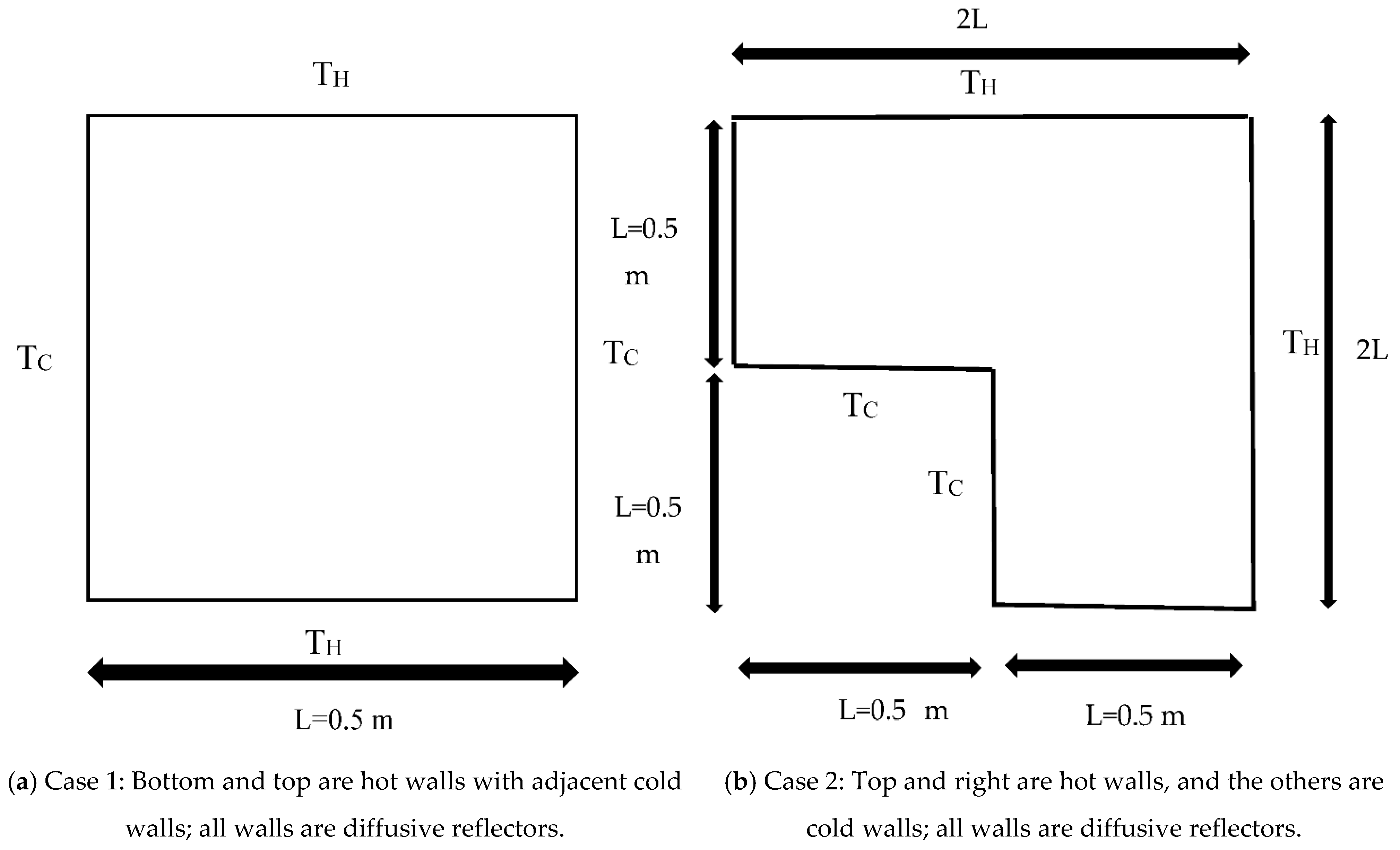

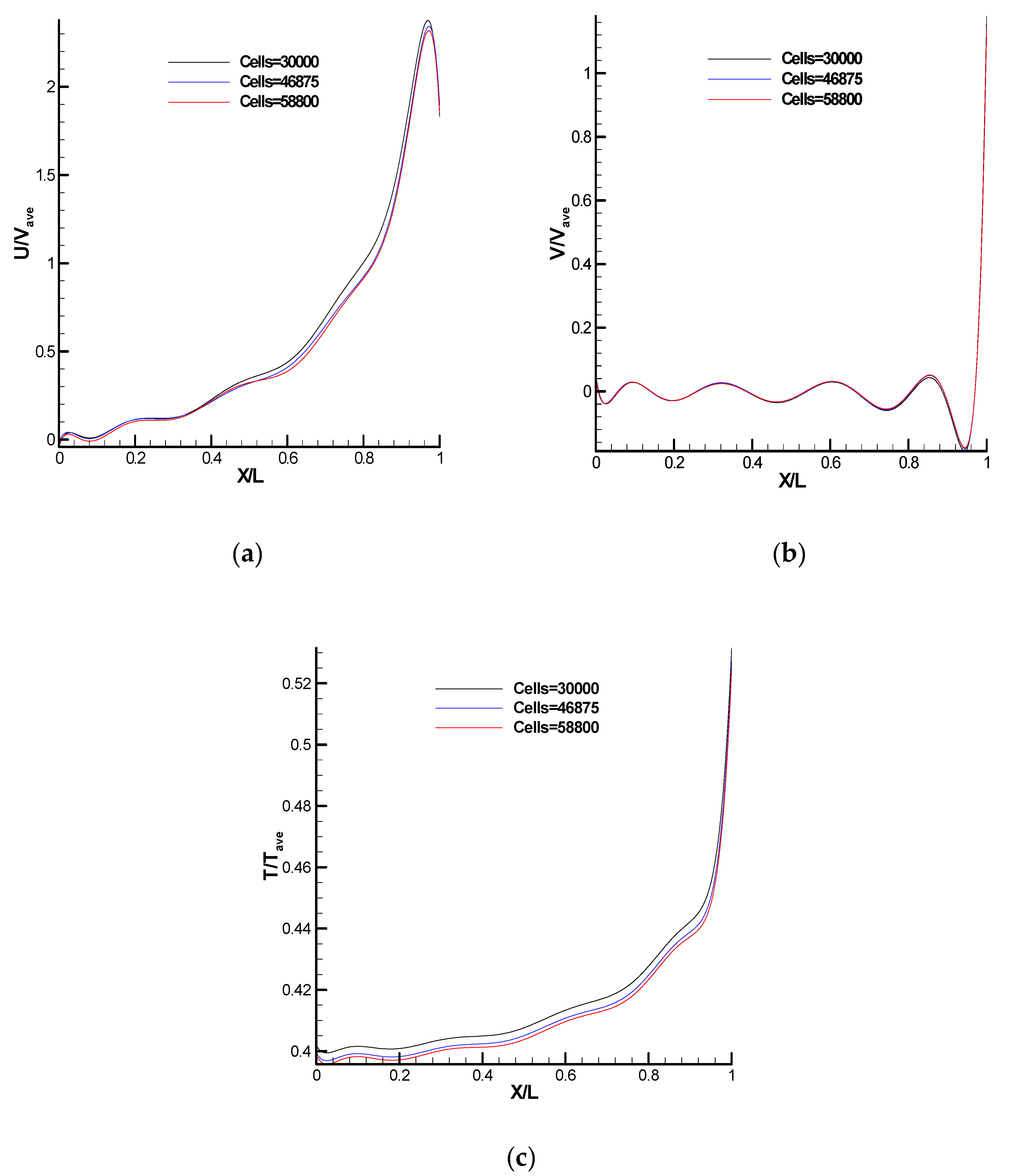
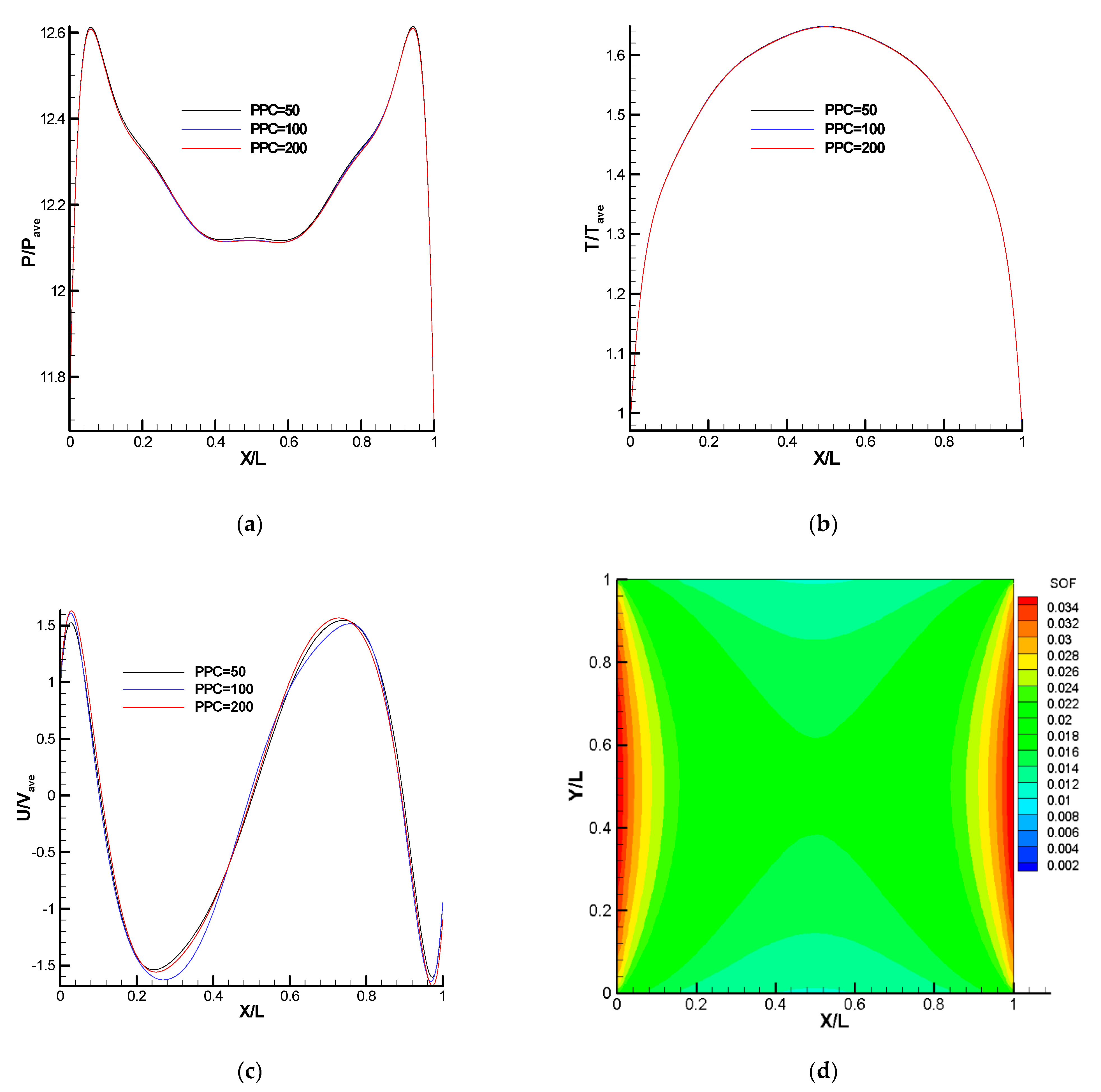
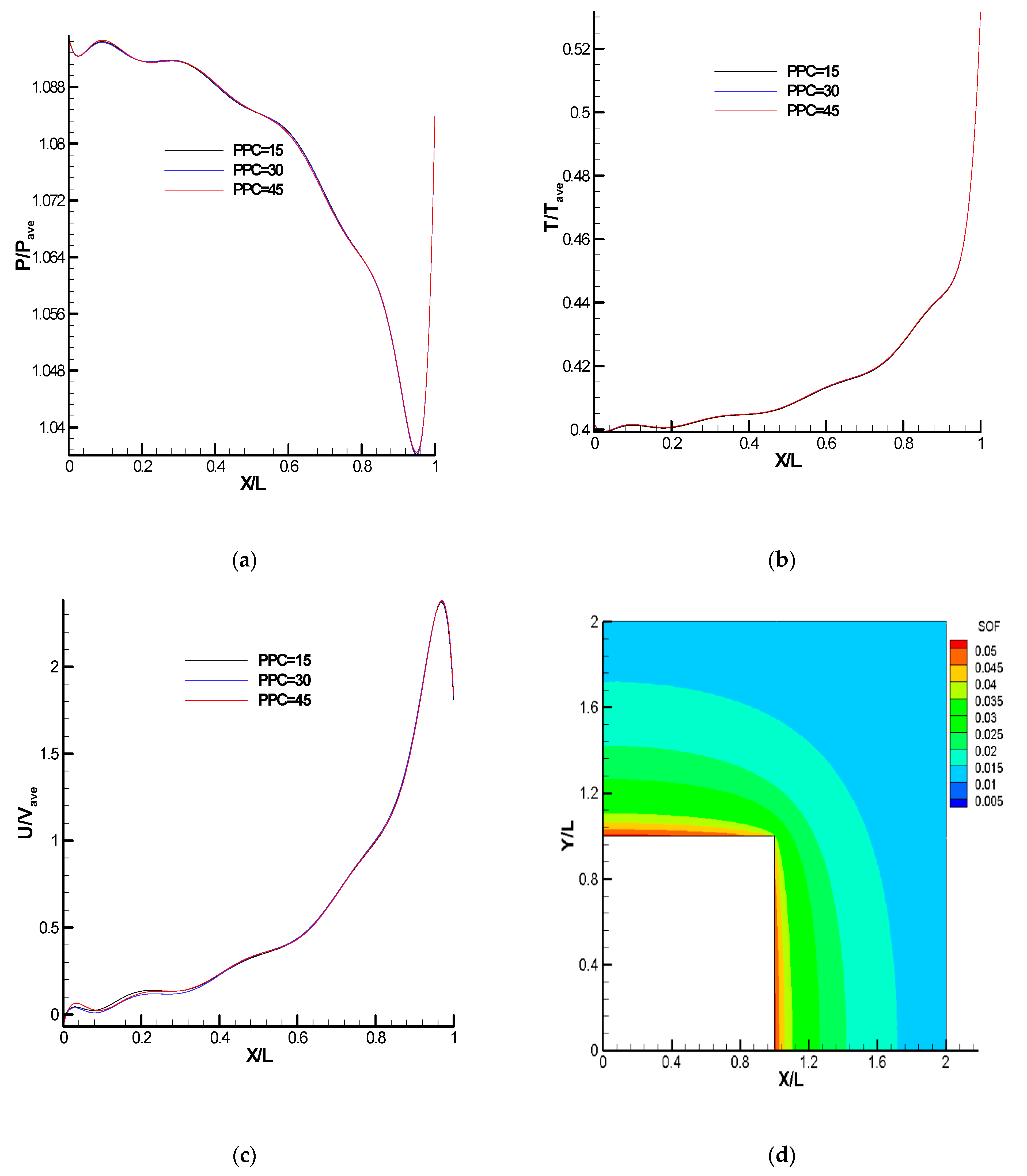
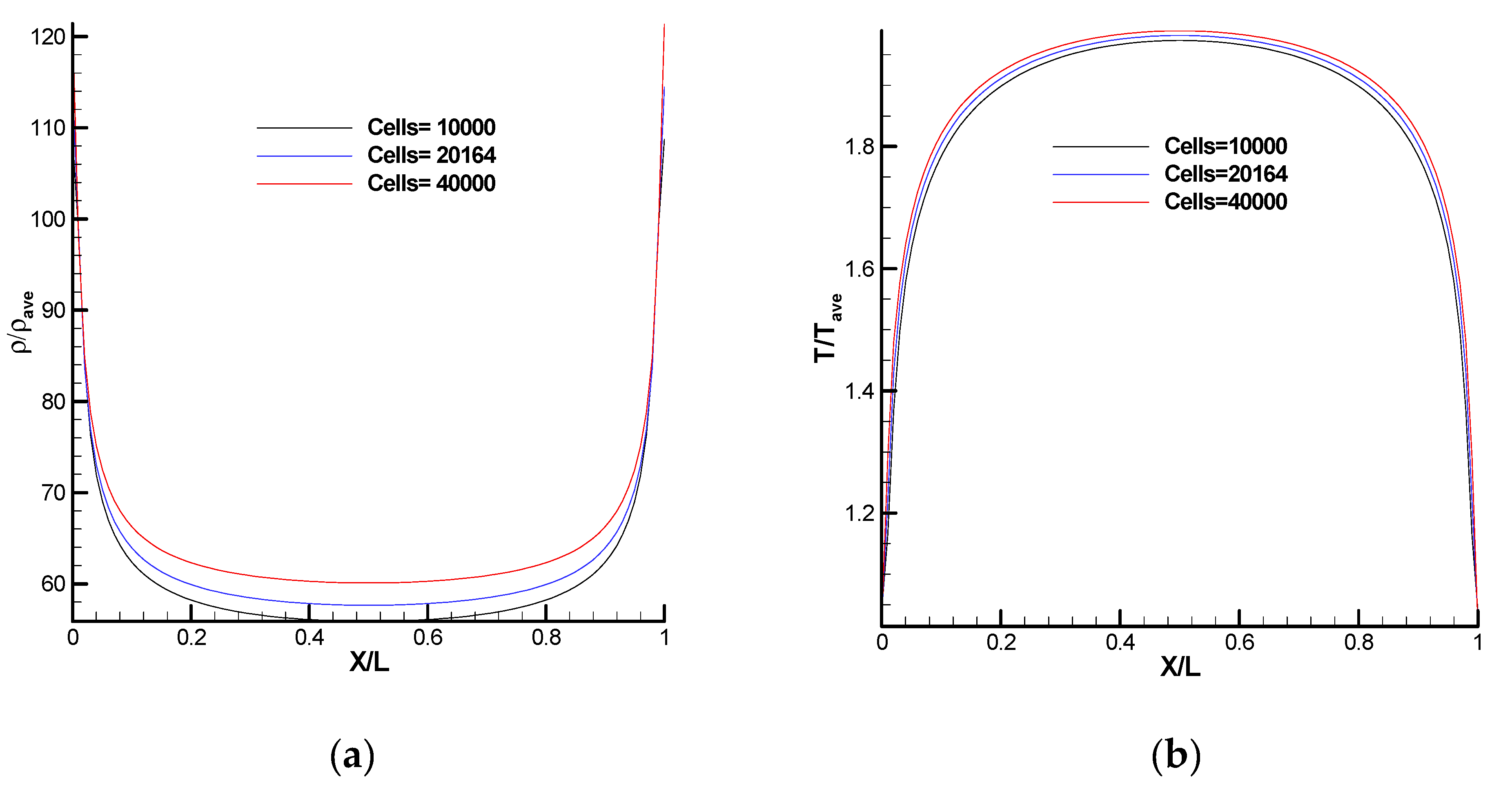

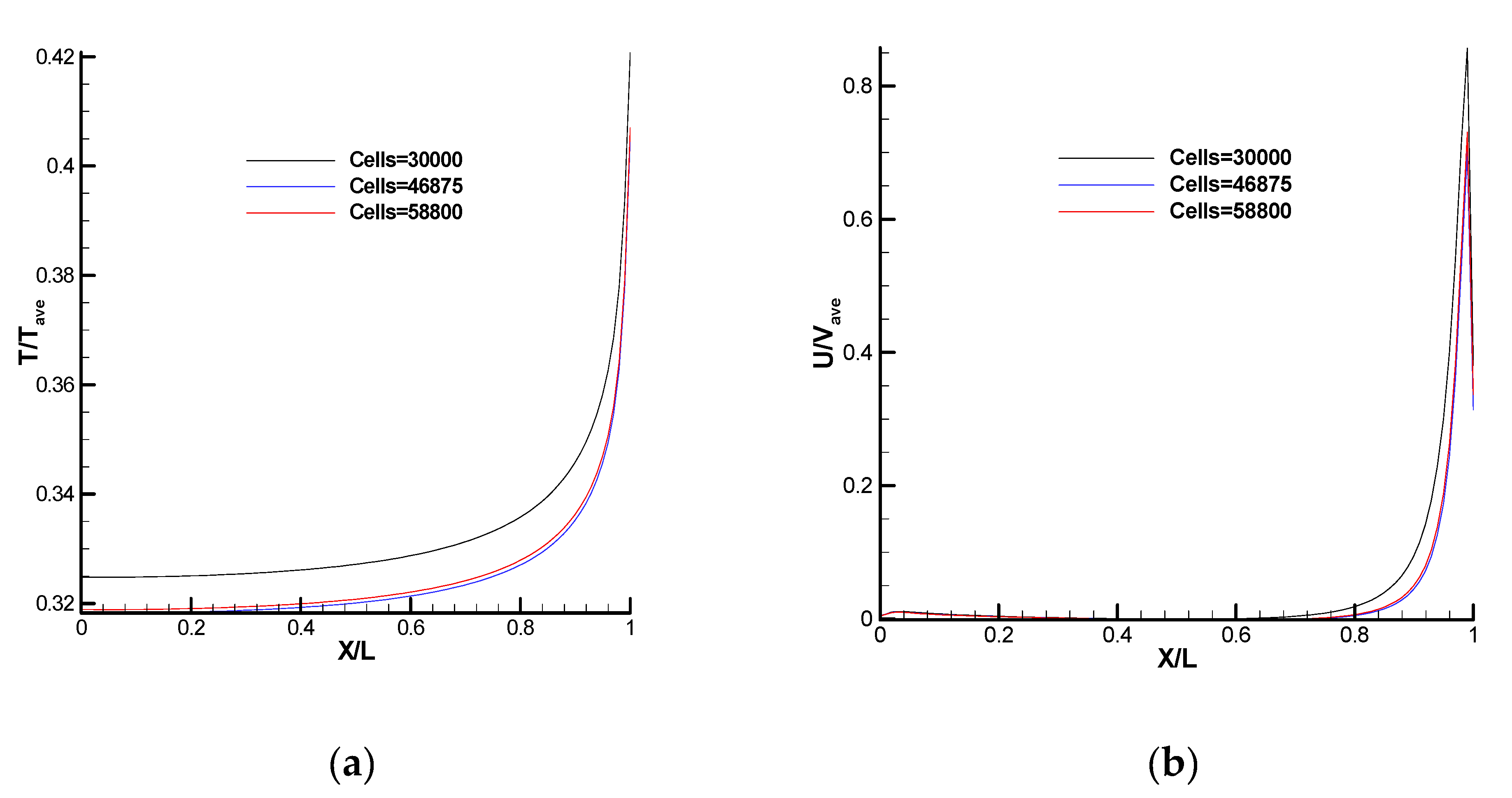
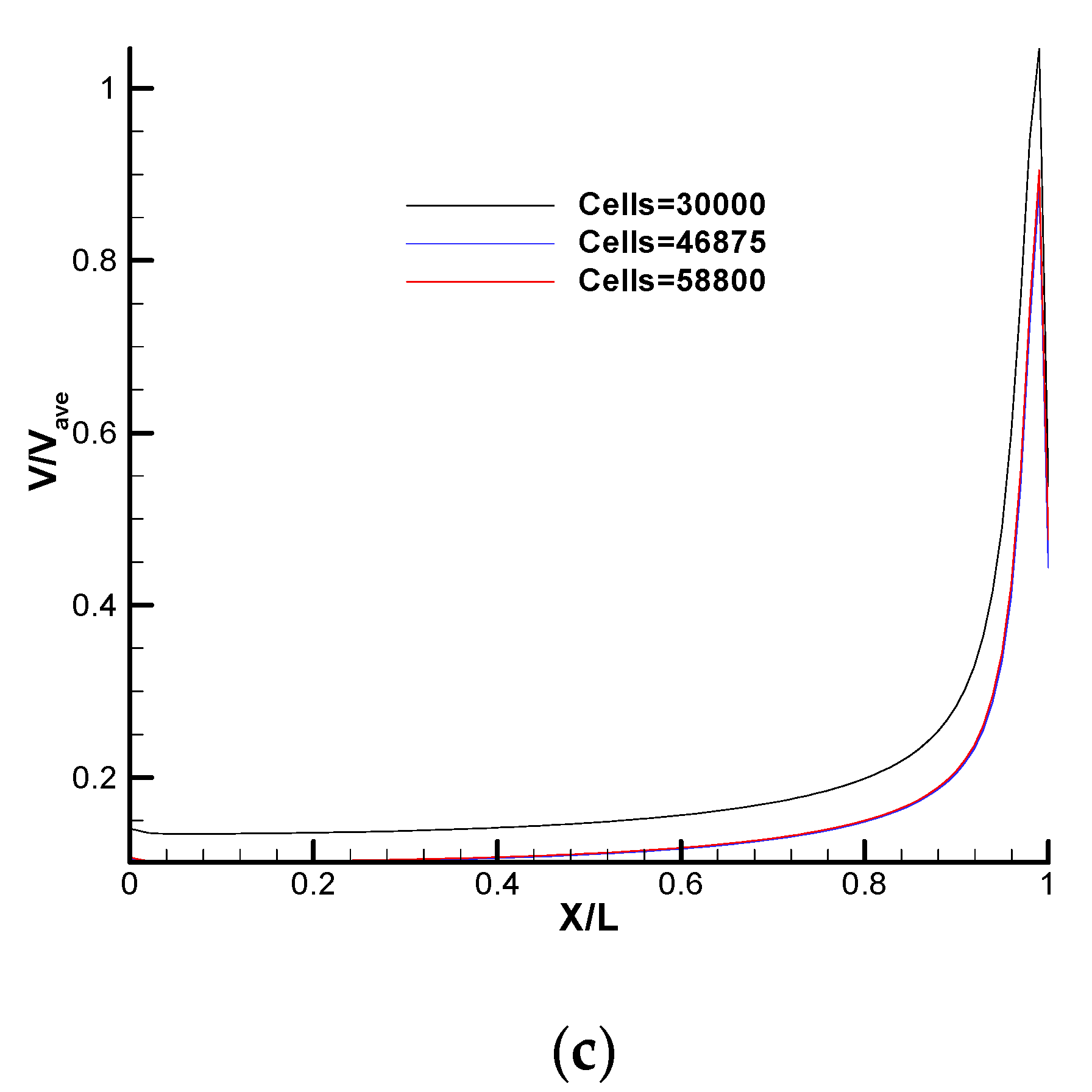

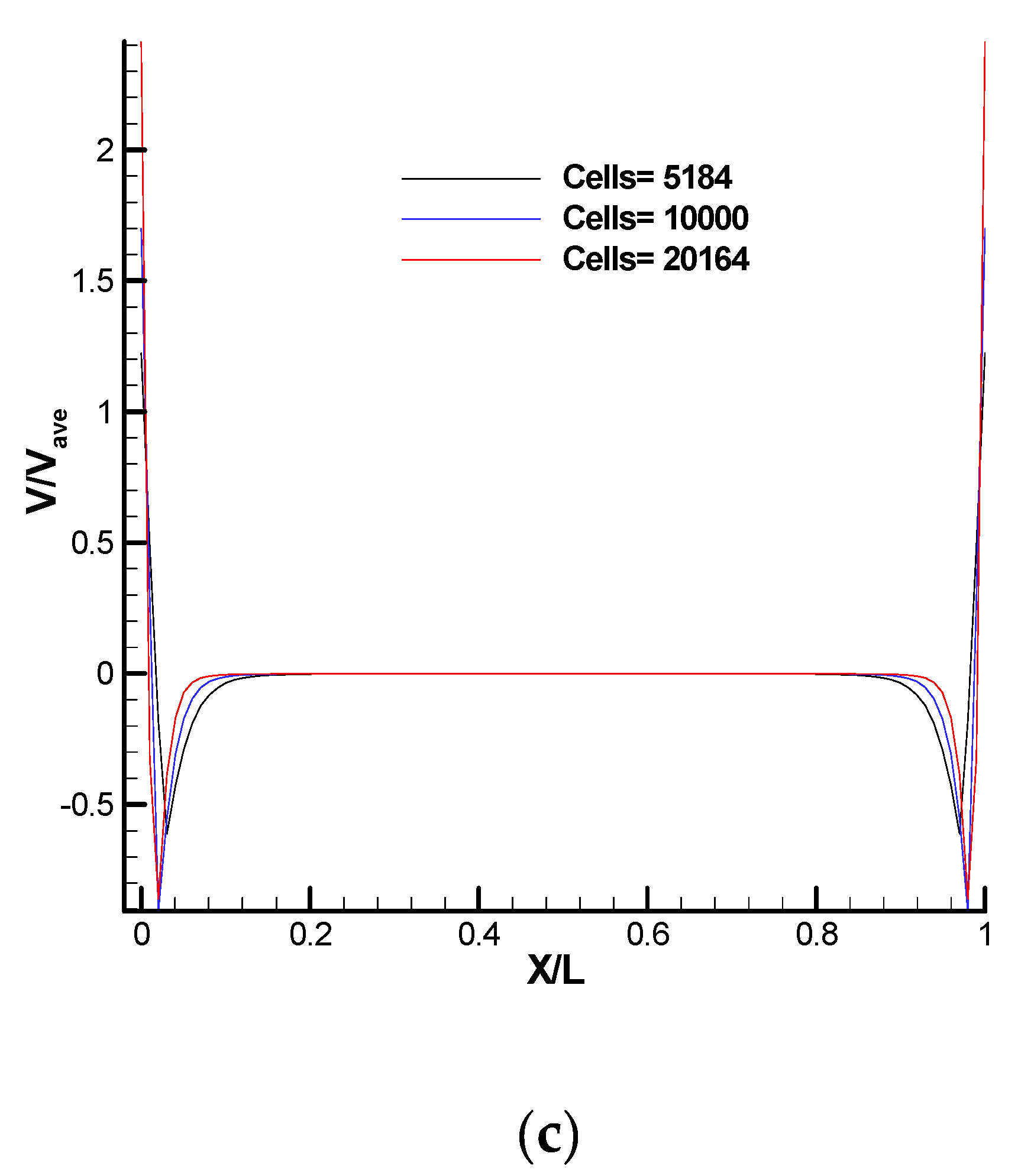
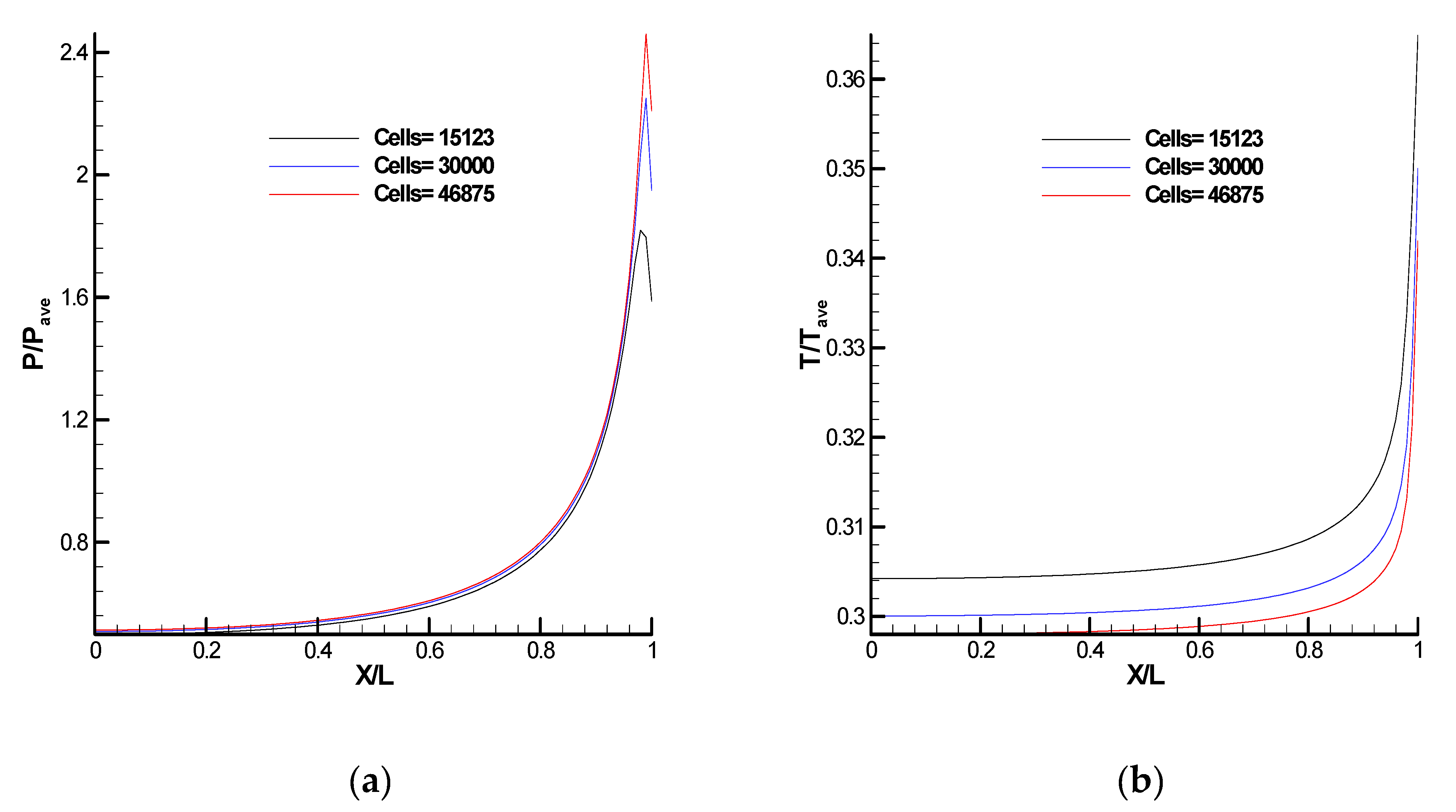
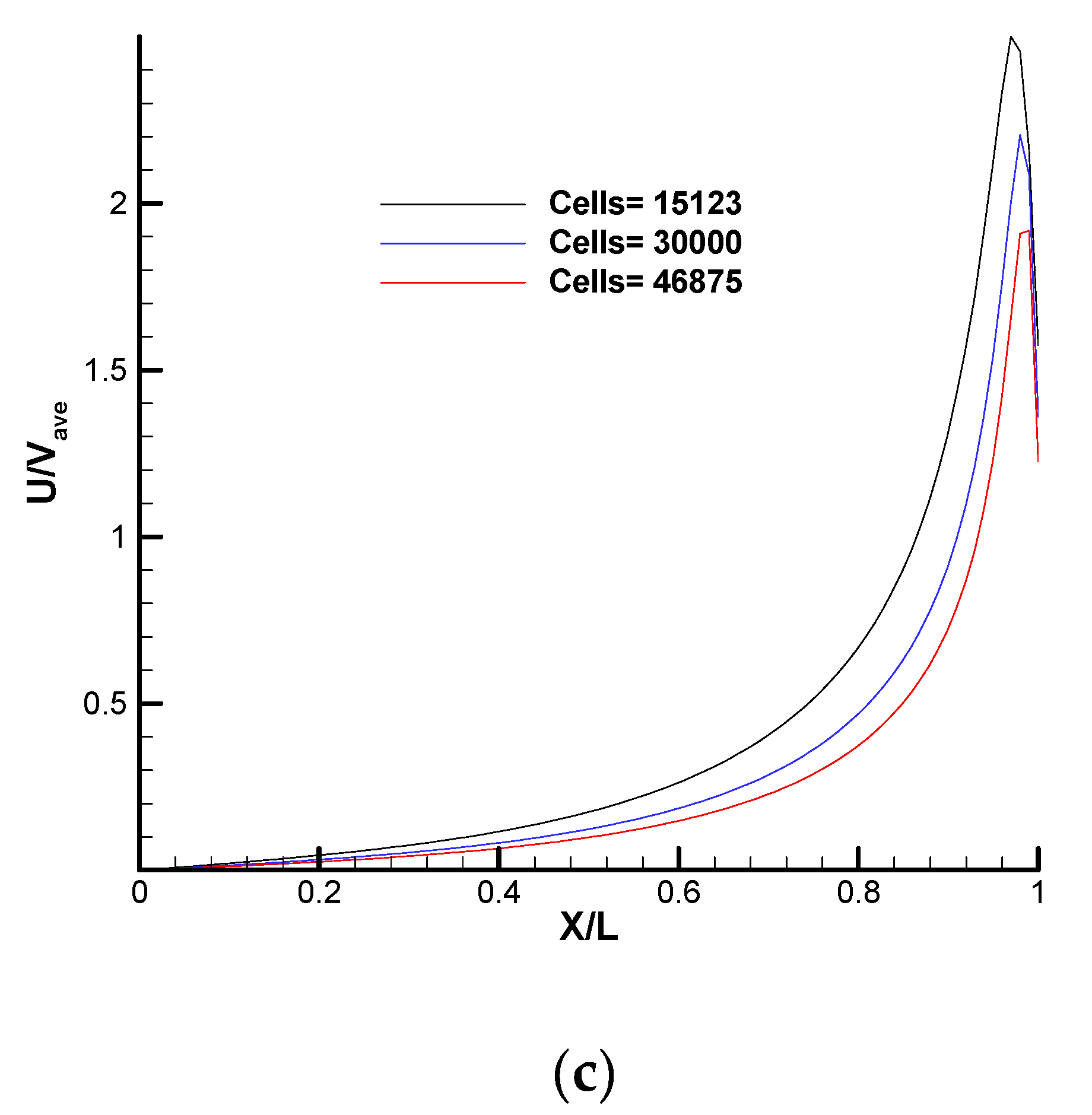

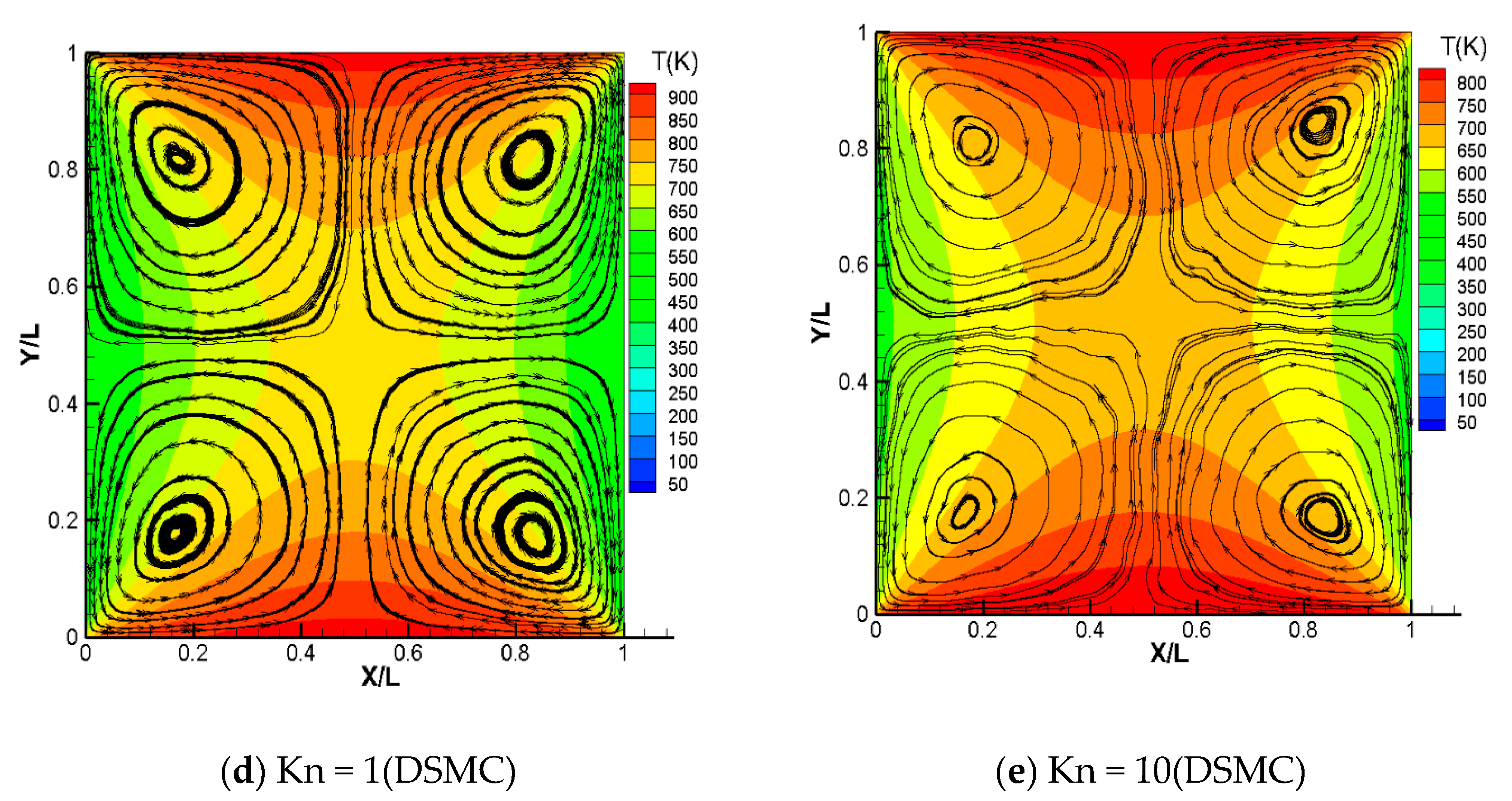
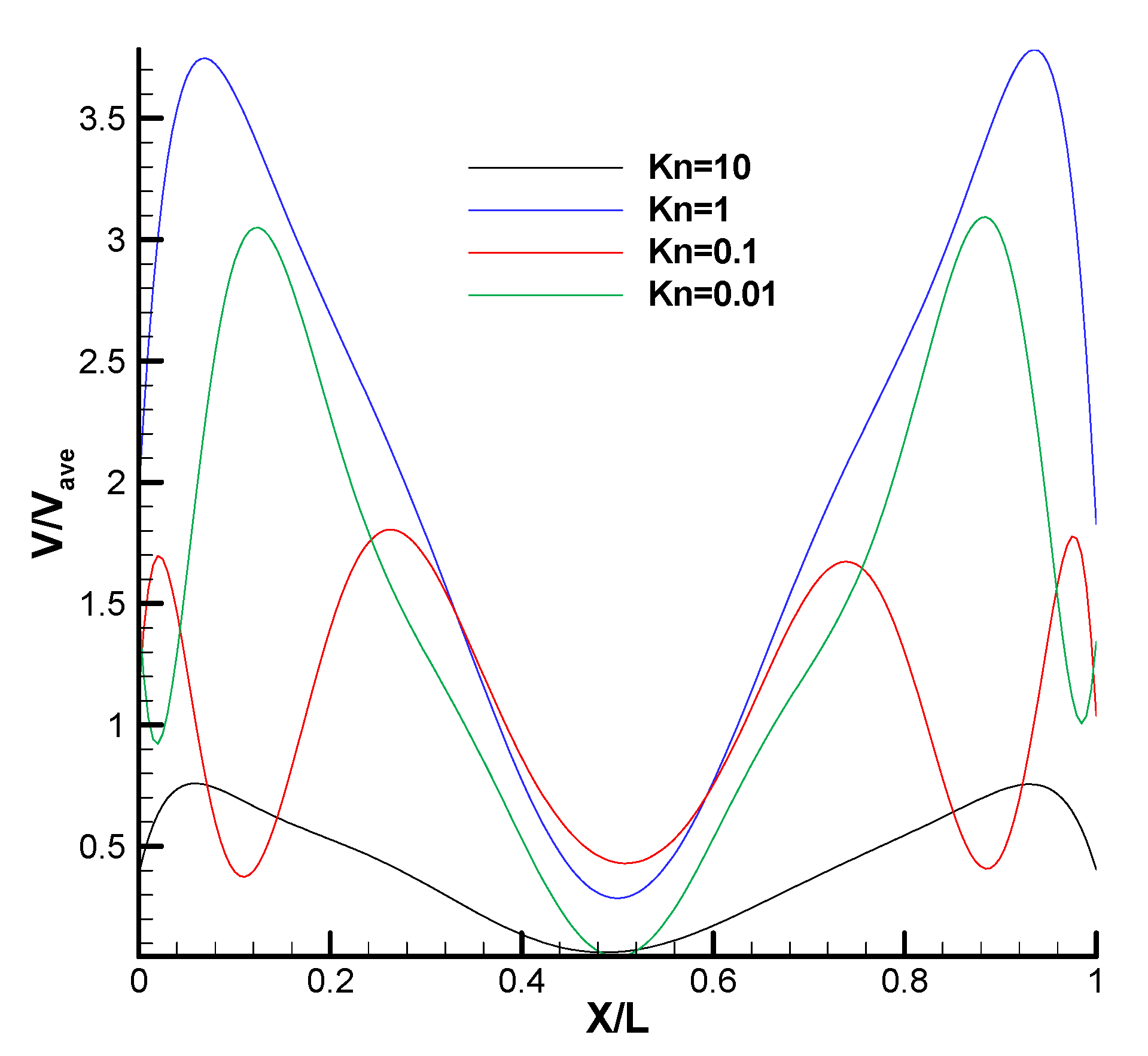
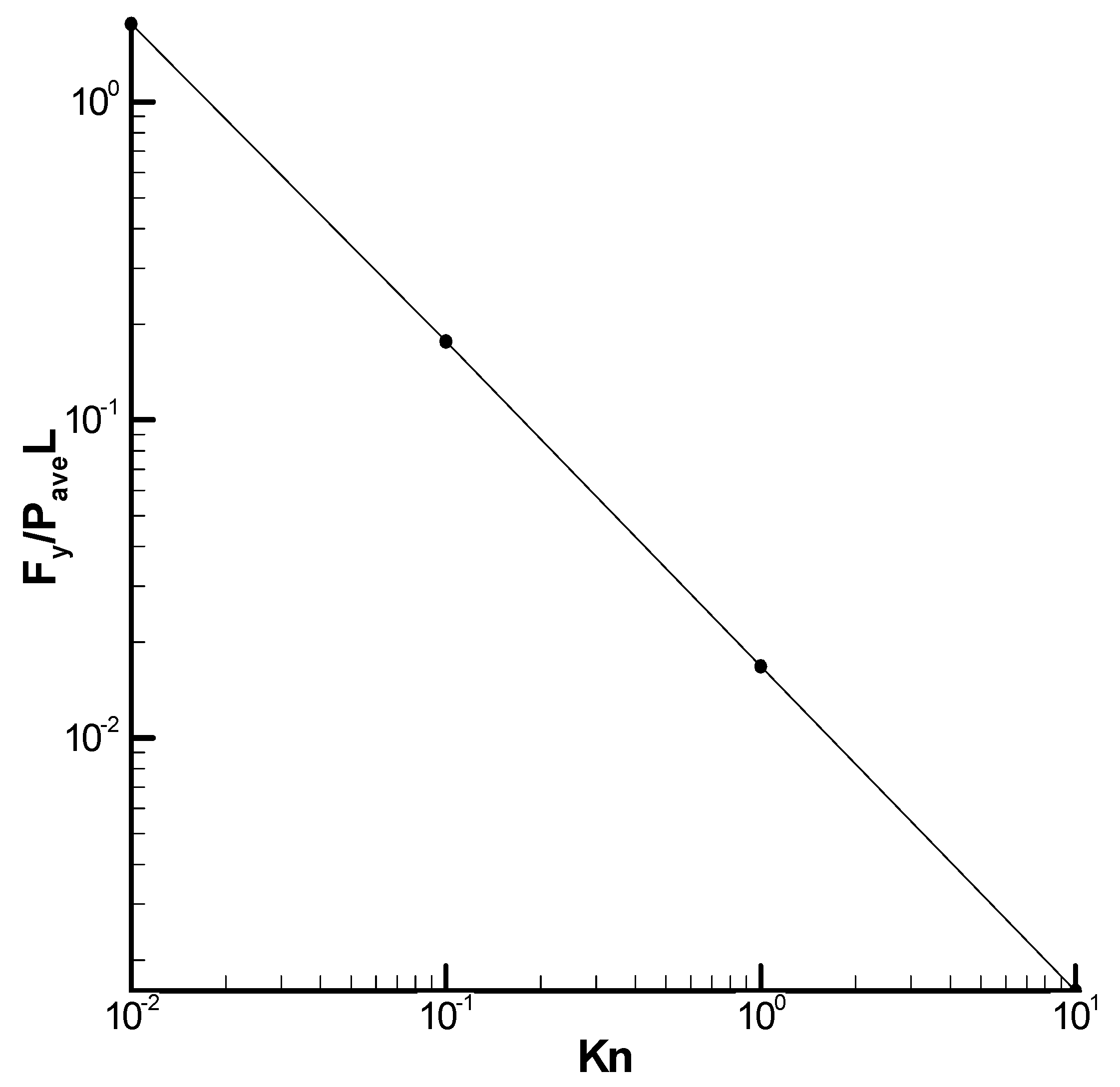
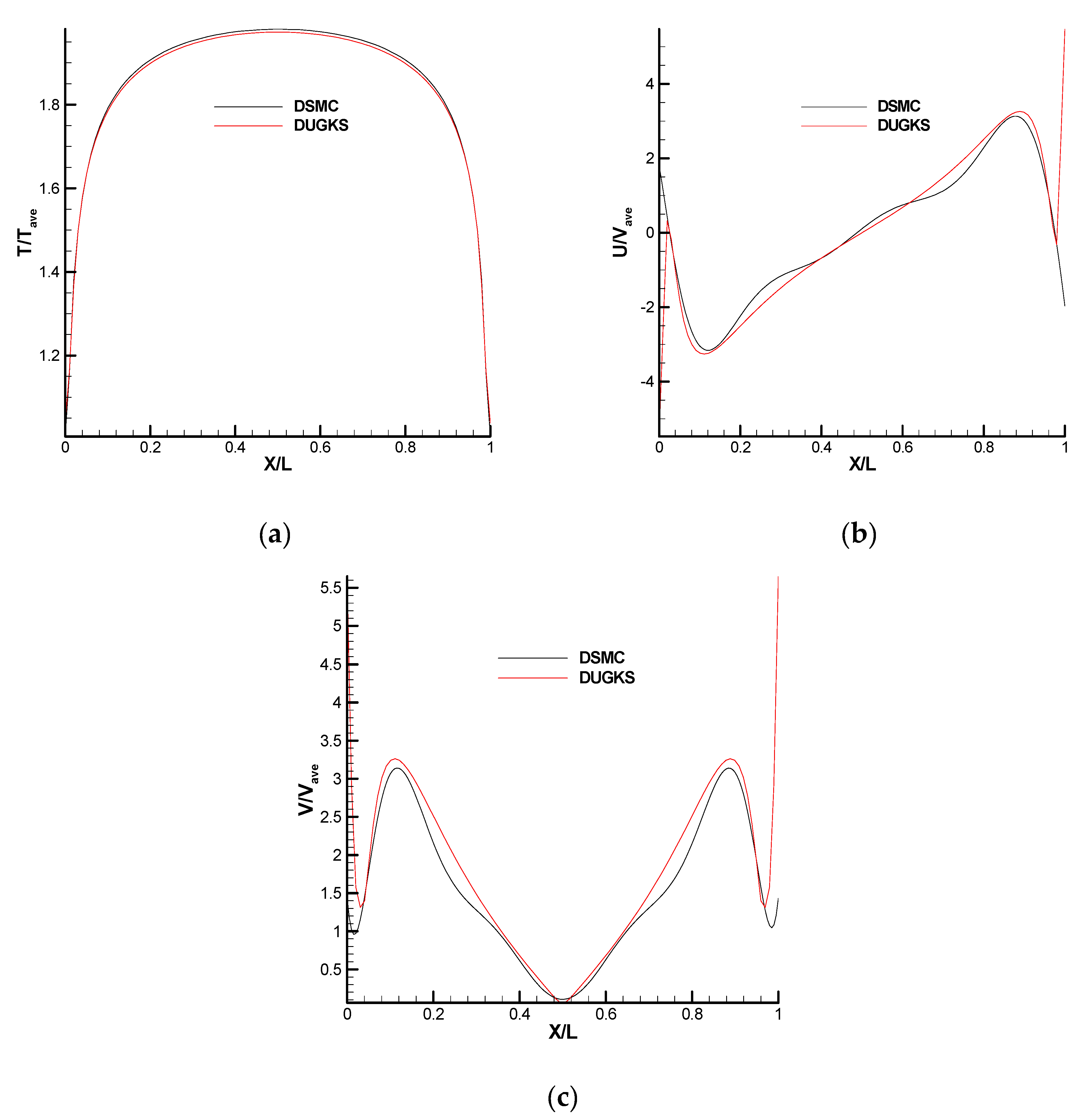
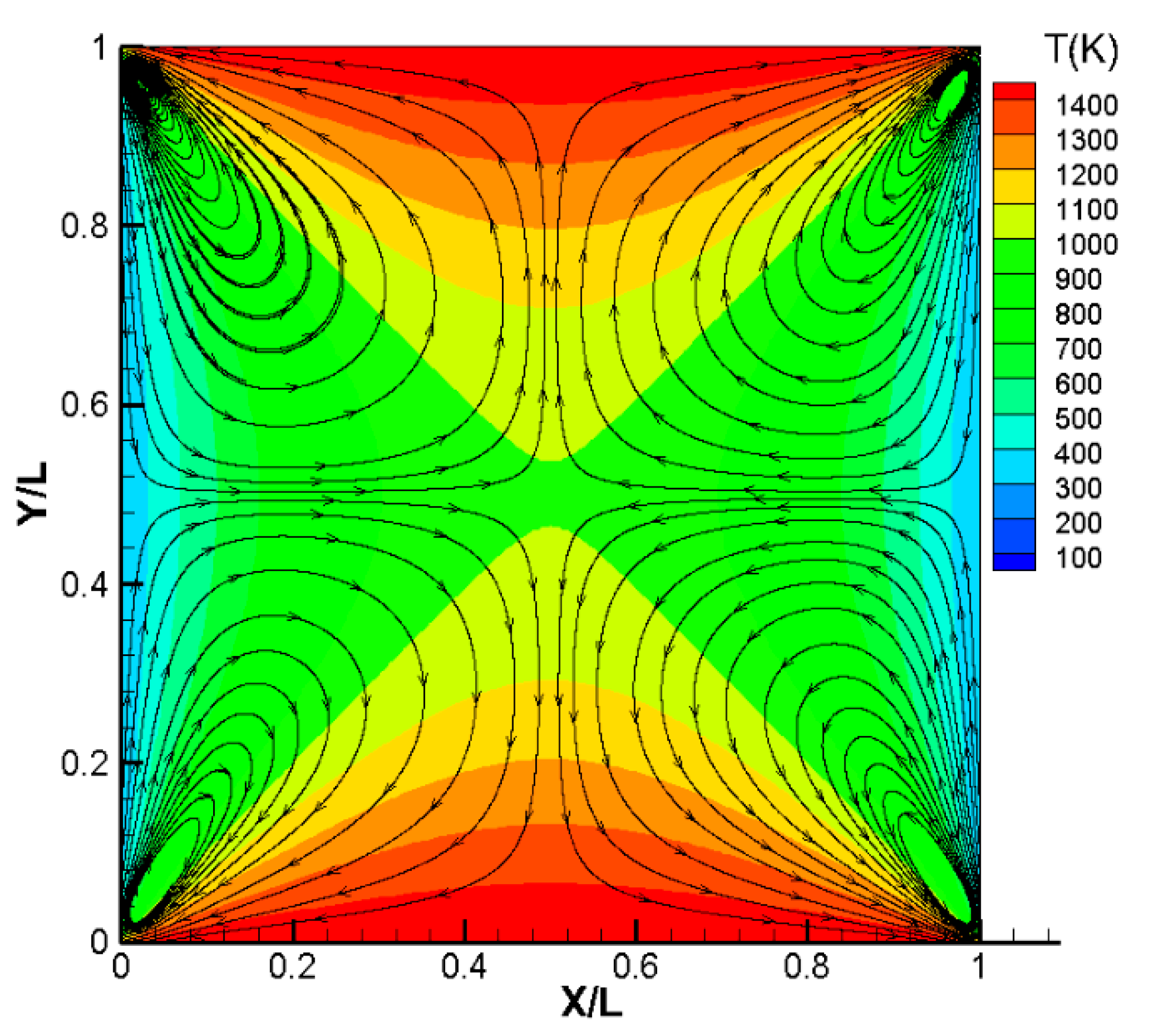

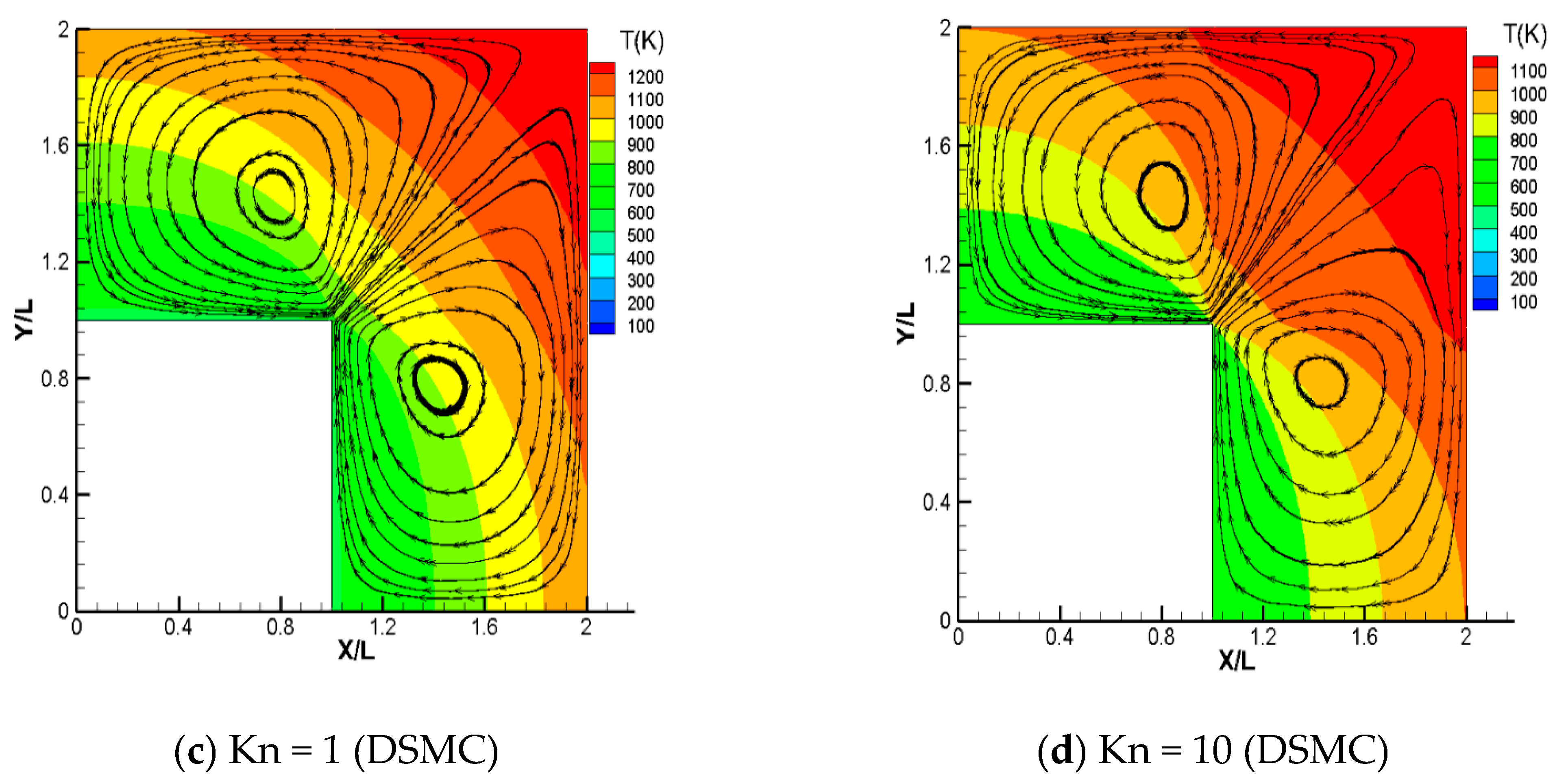
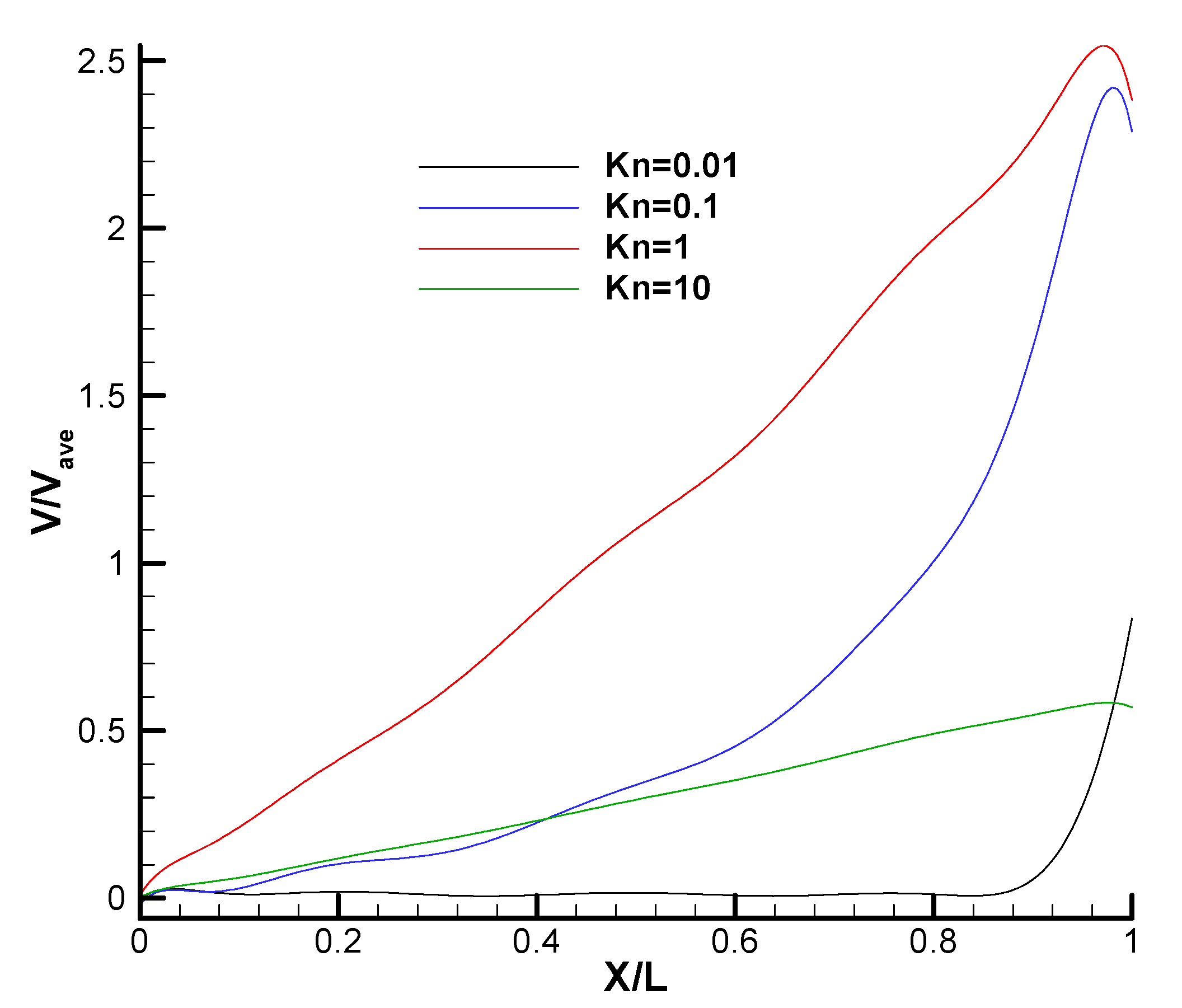
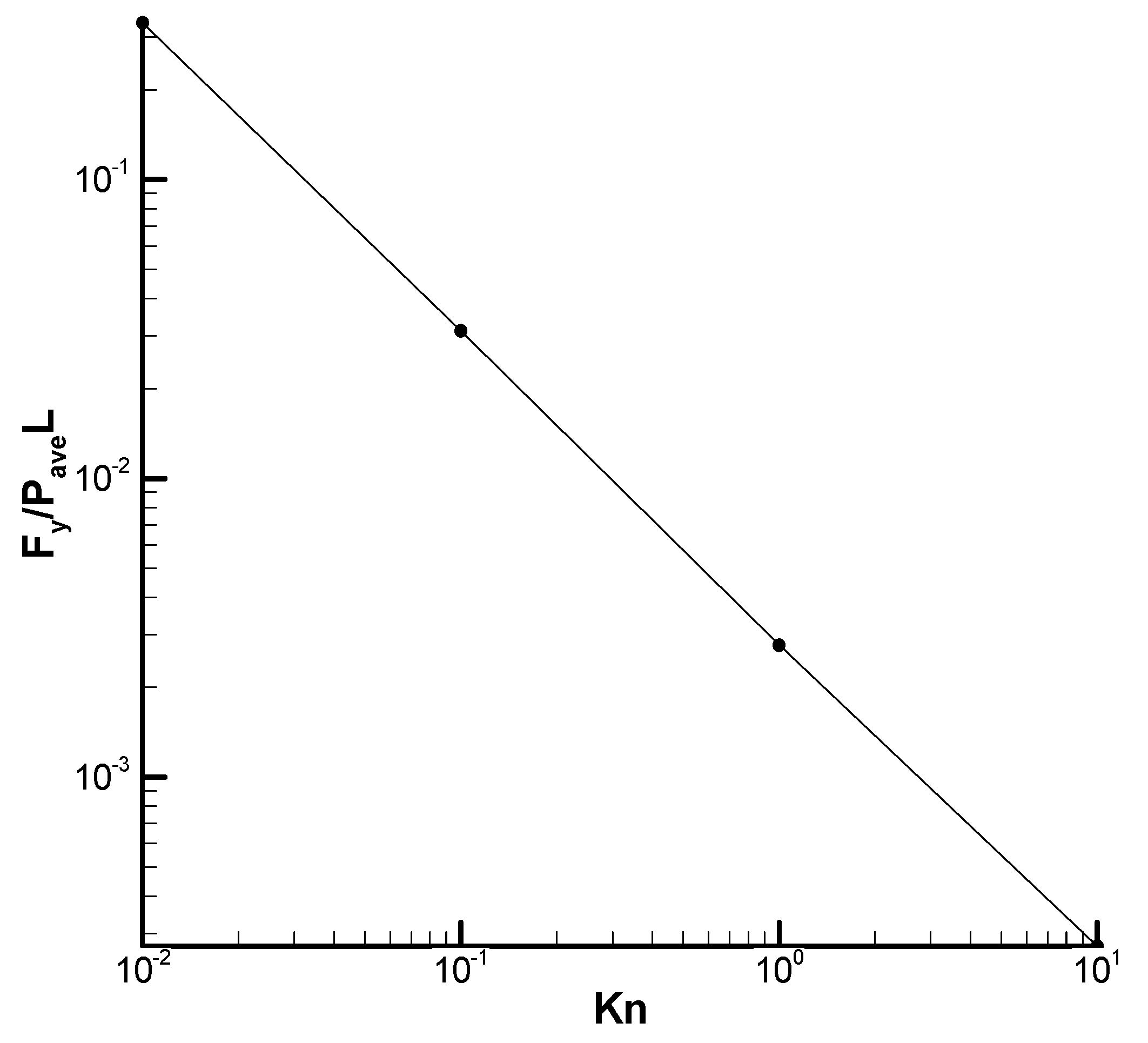
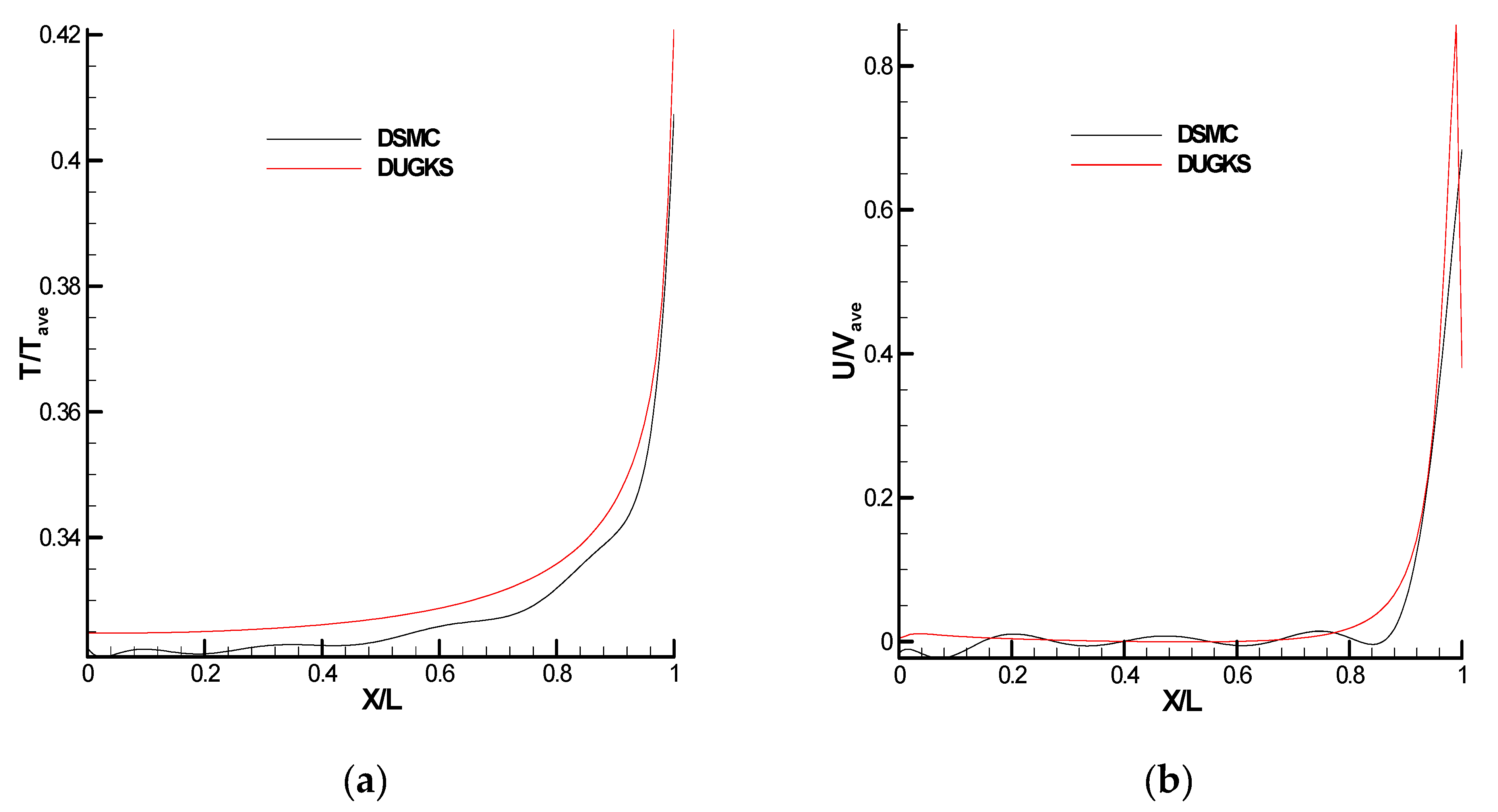
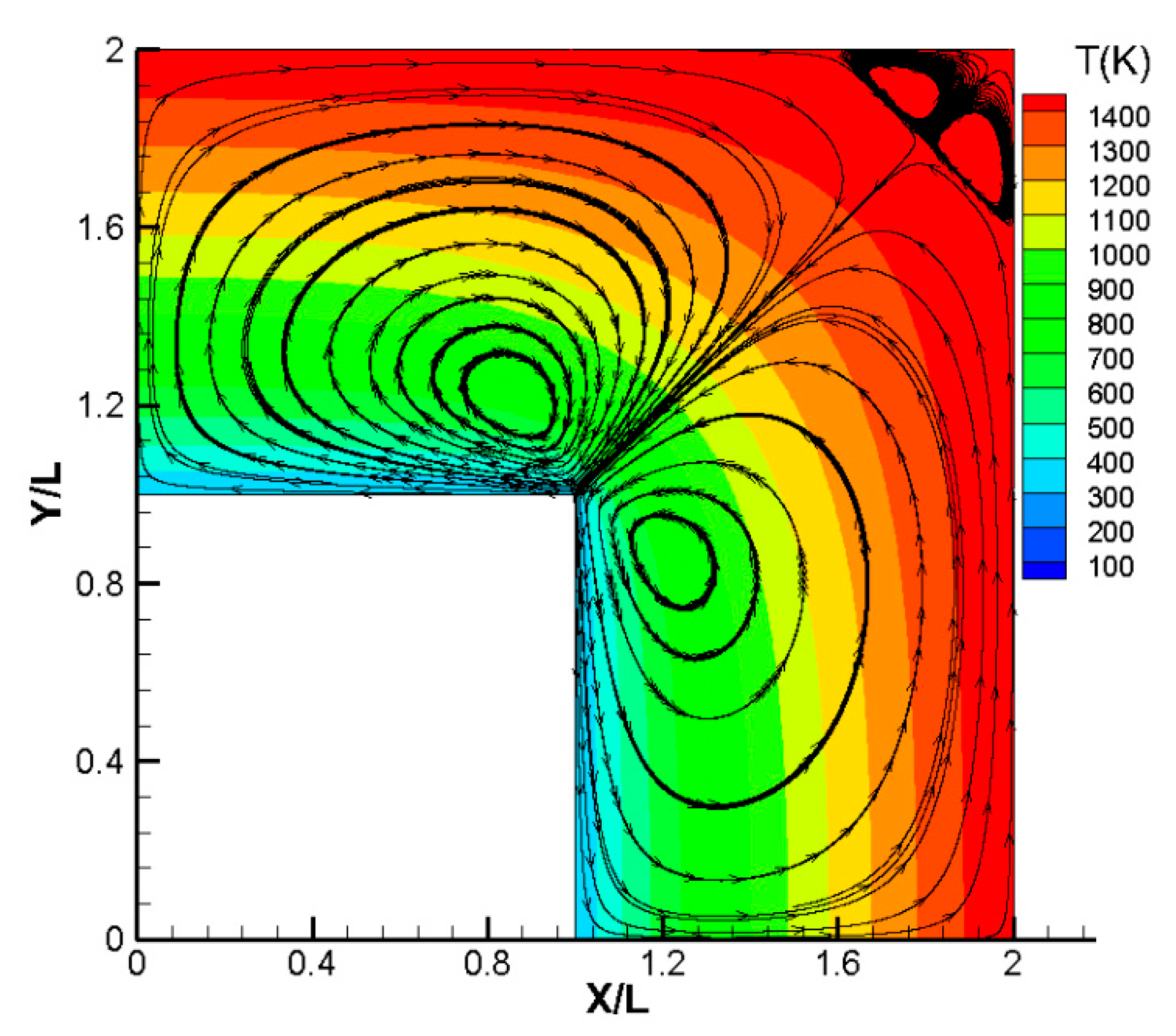

Publisher’s Note: MDPI stays neutral with regard to jurisdictional claims in published maps and institutional affiliations. |
© 2022 by the authors. Licensee MDPI, Basel, Switzerland. This article is an open access article distributed under the terms and conditions of the Creative Commons Attribution (CC BY) license (https://creativecommons.org/licenses/by/4.0/).
Share and Cite
Mousivand, M.; Roohi, E. On the Rarefied Thermally-Driven Flows in Cavities and Bends. Fluids 2022, 7, 354. https://doi.org/10.3390/fluids7110354
Mousivand M, Roohi E. On the Rarefied Thermally-Driven Flows in Cavities and Bends. Fluids. 2022; 7(11):354. https://doi.org/10.3390/fluids7110354
Chicago/Turabian StyleMousivand, Mostafa, and Ehsan Roohi. 2022. "On the Rarefied Thermally-Driven Flows in Cavities and Bends" Fluids 7, no. 11: 354. https://doi.org/10.3390/fluids7110354
APA StyleMousivand, M., & Roohi, E. (2022). On the Rarefied Thermally-Driven Flows in Cavities and Bends. Fluids, 7(11), 354. https://doi.org/10.3390/fluids7110354







